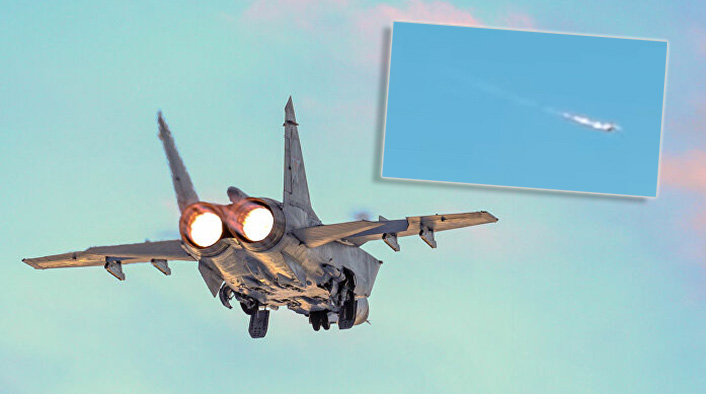Having a fire on board is one of worst emergency conditions for a combat pilot.
As we have already reported here at The Aviationist, a Kazakh MiG-31 “Foxhound” supersonic jet crashed near Karaganda airfield in Kazakhstan on April 16, 2020. A video posted on social media seems to show a clear engine fire situation.
The MiG-31 was born in response to a specification of the command of the then Soviet air defence for a high-performance interceptor, which offered greater flexibility of use and not GCI dependency. The aim was to create an aircraft capable of defending the Soviet Union’s airspace against the threat posed by cruise missiles, whether carried by planes (such as the Boeing B-52), or launched by land or naval systems (in particular BGMs-109 Tomahawk). Furthermore, its purpose was also to be able to intercept supersonic bombers, such as the Panavia Tornado and the B-1.
The Foxhound has always been fascinating because of its size and the fact that it can reach supersonic speeds up to Mach 2.83, which is why many aircraft structures are also made of titanium in order to resist heating due to speed. This detail is particularly important for the considerations that we will make later.

Back to the Apr. 16 accident, the Kazakh Defence Minister has ordered an investigation into the incident; what we can do is to go in depth on some technical aspects that are not very well known (and speculate a bit on the possible root causes, based on experience and also analysis of similar mishaps).
Having flown about 3,000 hours on military jets and in particular on aircraft with two engines (like the Tornado and M-346) I can surely say that, as on all planes, an “engine fire” represents what is called a “major and catastrophic” emergency which in many cases leads to a crash. Fire is generally caused by a mechanical failure of the rotors and stators of the engines or by fuel leaks. However, on two-engine planes, like the FOXHOUND, one-engine fire can be managed and a safe landing is still possible. Much depends on the fire detection system and its management. On the Tornado, for example, as in most planes, there are valves (one for each engine) that allow you to stop the fuel flow to the engines; subsequently you can activate a system of fire extinguishers to put out the fire. The sequence in which these steps are activated is very important and they are called BOLD FACE: these are actions that the pilot must do immediately and without looking at the emergency checklist, “by heart”, and which are crucial to solve the emergency.
Here is a first question: did the pilot correctly do the BOLD FACE? Any delay in correct actions makes the difference between a crash and a safe landing.
A further consideration derives from the presence of titanium. If the engine is built with titanium parts (and this is normally the case due to high temperature of working turbines section or combustion chambers) an engine fire can lead to a Turbin Blade Titanium Fire even where small spheres of titanium are generated by melting titanium parts. These spheres are thrown across the engine bay reaching the other engine (especially if the engines are very close each other like in the MiG-31) and damage fuel pipes line. As a consequence, the fire spreads from one engine to another possibly leading to a dual engine fire and an ejection. On the Tornado, for example, this Titanium Fire was a catastrophic emergency with its own BOLD FACE procedure that allowed the pilot extinguish the fire in both engines.
Considering what we have just exposed but also taking into account the fact that many sources report that the aircraft had just taken off (meaning that the engines were highly stressed and brought to maximum performance) and the aircraft had also transitioned from a low altitude (where there is a significant risk of birdstrike and FOD), we can’t rule out two possible root causes for the MiG-31 crash: 1) a real mechanical failure to an engine that erupted during a critical phase such as the take-off leading to a total failure (with possible titanium effect) of the engines; 2) a possible bird strike to one engine or even a multiple bird strikes during the take-off phase which caused breakages to the engine rotors or engine stators and consequently produced fire to the engines.

Fire on board is not even simple to manage from a psychological point of view: in a second, billion considerations are elaborated by your brain. Fighter pilots train a lot on this type of emergency. When it is no longer possible to continue flying safely, to limit any other damage to the population, pilots are instructed to use the last 2-3 seconds to direct the plane towards uninhabited areas. And in this case, I must say that the pilot had cold blood to direct his plane before ejecting himself.








